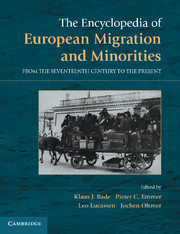Book contents
- Frontmatter
- Contents
- Preface to the English Edition
- Preface to the German Edition
- The Encyclopedia: Idea, Concept, Realization
- Terminologies and Concepts of Migration Research
- Countries
- Northern Europe
- Western Europe
- Central Europe
- Southern Europe
- East-Central Europe
- The Baltic Region: Estonia, Latvia, Lithuania
- Poland
- Czechia and Slovakia
- Southeastern Europe
- Eastern Europe
- APPENDIX
- Index of Migration Types
- Index of Countries, Regions, and Places
- References
Poland
from East-Central Europe
Published online by Cambridge University Press: 05 June 2012
- Frontmatter
- Contents
- Preface to the English Edition
- Preface to the German Edition
- The Encyclopedia: Idea, Concept, Realization
- Terminologies and Concepts of Migration Research
- Countries
- Northern Europe
- Western Europe
- Central Europe
- Southern Europe
- East-Central Europe
- The Baltic Region: Estonia, Latvia, Lithuania
- Poland
- Czechia and Slovakia
- Southeastern Europe
- Eastern Europe
- APPENDIX
- Index of Migration Types
- Index of Countries, Regions, and Places
- References
Summary
During Poland’s early modern history, far more people emigrated than immigrated. The country has experienced larger influxes only during a few phases of the early modern period and since the turn of the 20th century. Since the beginning of the 19th century, at least 7 million people have left Poland, whose population stood at more than 38 million in 2005. Mass emigrations commenced in the middle of the 19th century; they reached their height at the beginning of the 20th century and have continued, with a few interruptions, until the early 21st century.
Today, at least 15 million people of Polish extraction live outside Poland around the world. The Polish diaspora (Polonia) has become a central element in Polish collective memory. Among the most important target countries were the USA, Germany, and France, but also Brazil, Canada, Argentina, Great Britain, Australia, and Sweden. Moreover, because of the numerous shifts in the border between Poland and the Russian Empire and the USSR, many Poles and people of Polish origin continue to live in Russia and other successors states of the Soviet Union, especially in Belarus, Ukraine, Lithuania, and Kazakhstan. Alongside outflows that were economically motivated and some of which represented seasonal migrations, the Polish population experienced numerous refugee movements, forced resettlements, and deportations, especially in the 19th and 20th centuries.
- Type
- Chapter
- Information
- The Encyclopedia of European Migration and MinoritiesFrom the Seventeenth Century to the Present, pp. 143 - 151Publisher: Cambridge University PressPrint publication year: 2011
References
- 1
- Cited by

